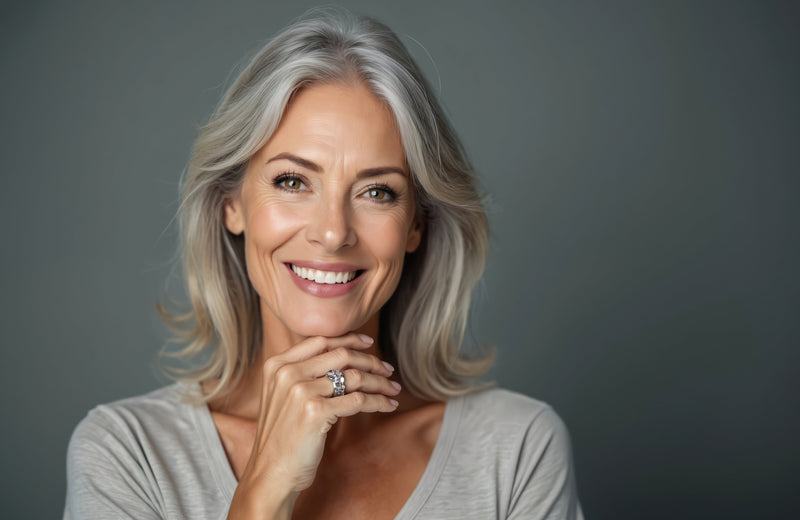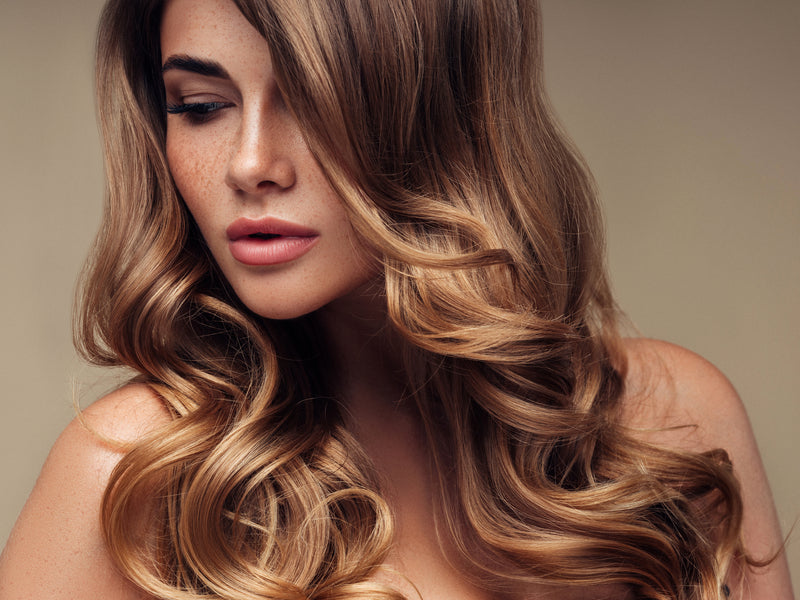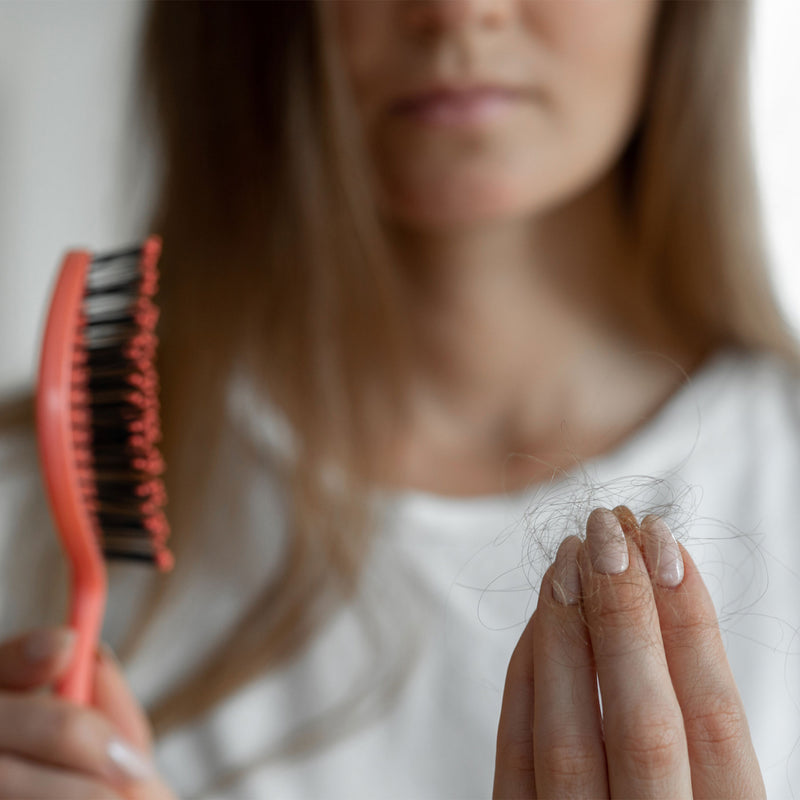
Scalp Health 101: Why Healthy Hair Starts at the Root
Your scalp is the foundation of your hair. When it’s nourished, balanced, and protected, hair looks fuller, stronger, and healthier—because great hair always starts at the root.

Scalp Health 101: Why Healthy Hair Starts at the Root
Your scalp is the foundation of your hair. When it’s nourished, balanced, and protected, hair looks fuller, stronger, and healthier—because great hair always starts at the root.

The Hidden Impact of Hair Changes on Perceived Age: What Science Reveals
In our youth-obsessed culture, we often downplay the emotional impact of hair changes. The discrepancy between rejuvenated faces and thinner appearing hair that frames the face highlights the importance of a holistic approach to anti-aging consultation.

How Moms Can Beat Postpartum Hair Loss with the Right Hair Care Routine
The hormonal changes during pregnancy and postpartum can cause hair to fall out at a faster rate than usual. But don't worry, there are ways to combat postpartum hair loss and restore your hair volume.

Unlock the Secrets to Thicker, Longer Lashes Naturally
Long, thick eyelashes are coveted by beauty enthusiasts across the globe. They frame the eyes, enhance expression, and add a touch of glamour to any look. But not everyone is blessed with naturally voluminous lashes. Fear not, for achieving luscious lashes isn't solely the domain of makeup artists and beauty professionals. Here are some expert tips to help you naturally enhance the length and thickness of your eyelashes.1. Nutritional FoundationLike the hair on your head, your eyelashes need the proper nutrients to grow thick and strong. Incorporate a balanced diet rich in protein, biotin, vitamins A, C, and E, and omega-3 fatty acids. Foods like fish, eggs, beans, and greens can be lash lifesavers.2. Gentle GroomingBe gentle with your lashes. Avoid rubbing your eyes harshly and be soft when applying or removing makeup. Always use a non-irritating makeup remover and ensure you clean your eyelashes thoroughly but gently every night.3. Moisturize and ConditionJust as you condition the hair on your scalp, your eyelashes also benefit from hydration. Natural oils like castor oil, coconut oil, and vitamin E oil can be applied to the lashes before bedtime to nourish and strengthen them.4. Limit False Lashes and Heavy MascaraWhile it might be tempting to use false lashes or heavy mascara to give your lashes a boost, frequent use can lead to damage and loss. (Learn how) Instead, opt for lighter mascaras and give your lashes a break from falsies to prevent breakage and fallout.5. Lash SerumsConsider investing in a quality lash serum that supports growth. Look for products with peptides, biotin, or natural growth-promoting ingredients. Products like our own Actsyl-L Lash Growth Express incorporate all the necessary ingredients plus innovative and proven peptides without harmful side effects. Apply as directed, usually once a day, to stimulate growth at the follicles.6. Eyelash MassageBelieve it or not, gently massaging the eyelid area and lash line can improve blood flow, which helps nutrients reach the hair follicles more efficiently. Use clean fingers and a light touch to avoid damaging the lashes.7. Avoid Waterproof MascaraWaterproof mascaras can lead to lash breakage due to the harsher removal process required. Choose a gentle, washable mascara instead, and make sure to remove it carefully every day.8. Be Patient and ConsistentEyelashes, like scalp hair, take time to grow. Be patient and consistent with your care routine. Most people will notice a change in their lashes after several weeks of consistent care.9. Consult a ProfessionalIf you're concerned about your lash health or are considering supplements or treatments, it's always best to consult with a dermatologist or a licensed aesthetician who can provide personalized advice.In ConclusionAchieving thicker, longer eyelashes is a blend of science and tender loving care. By nurturing your lashes from the inside out and treating them with the gentle respect they deserve, you can enhance their natural beauty. Remember, the key to gorgeous lashes is as much in the care as it is in the curl!

Uncovering the Secrets to Healthy Hair
Have you ever wondered why sometimes your hair feels like it’s growing like a weed, and other times it seems stuck in a standstill? Or perhaps why that friend who swears by their vitamin routine has locks that look straight out of a shampoo commercial? Let’s dive into the fascinating world of hair growth and uncover the secrets behind those luscious locks backed by some good ol' science.The Hair Growth Cycle DemystifiedFirst things first our hair isn’t always in the “growing” mode. It takes breaks too! Every strand on your head is on its unique growth journey, passing through distinct phases:1Anagen Phase (Growth Galore): Imagine this as the “all-out” phase. This is when your hair is all about growth. Cells are bustling, dividing rapidly, and adding length to your hair. Typically, hair grows about half an inch every month during this phase, and this can go on for a whopping 2 to 7 years!2Catagen Phase (The Cool-Down): After the growth frenzy, hair takes a brief 10-day respite. It's like your hair's mini-retreat, where it shrinks and slows things down.3Telogen Phase (The Relaxing Retreat): The hair is in full zen mode for about three months. It’s during the tail end of this phase that some hair decides it’s time to leave the scalp and make room for fresh new hair.4.Nourishing the Mane: Vitamins, Minerals, and ProteinEver heard the saying, “You are what you eat”? Well, your hair kind of abides by that rule too. Our hair is a testament to our dietary choices.Protein: Hair is predominantly keratin, a protein. Think of protein as the building blocks for your hair. A protein-rich diet ensures that the hair has the necessary building blocks to grow strong and resilient.5 Without enough protein in your diet, your hair can become weak, brittle, and even start shedding more than usual.Vitamins: B-vitamins, especially biotin, are hair's MVPs. They play a pivotal role in red blood cell formation, which transport oxygen and nutrients to the scalp and follicles.6 It’s like giving your hair a direct nutrient boost! Vitamins D and E also chip in, supporting healthy follicles and imparting a natural shine.7Minerals: Minerals play a vital role in hair growth and strength. Iron, zinc, and selenium are crucial for hair vitality.8 Iron, for instance, aids red blood cells in ferrying oxygen to hair follicles. An iron-deficient diet might leave your hair gasping for breath, leading to increased hair fall.9External Factors: Stress and StylingChronic stress is a notorious hair growth saboteur. It can send many hairs prematurely into the telogen phase, resulting in noticeable shedding.10 And for all the style enthusiasts, while heat tools and chemical treatments can give you a fab look, over time they can weaken and damage your hair. So, moderation is key, bacuse excessive use can compromise hair health.11Key Takeaways: While genes dictate some aspects of our hair health, our lifestyle choices, from diet to stress management, wield significant influence. The road to radiant hair is paved with balanced nutrition, mindful styling, and overall well-being. Remember, your hair is a reflection of your overall health, so take good care of it!References:Footnotes1American Academy of Dermatology Association - Hair Loss: Tips for Managing 2Harvard Health - Treating Female Pattern Hair Loss 3Rushton, D. H. (2002). Nutritional factors and hair loss. Clinical and Experimental Dermatology, 27(5), 396-404. 4Cleveland Clinic - Hair Structure and Hair Life Cycle 5Guo, E. L., & Katta, R. (2017). Diet and hair loss: effects of nutrient deficiency and supplement use. Dermatology Practical & Conceptual, 7(1), 1. 6Trüeb, R. M. (2019). The impact of oxidative stress on hair. International Journal of Cosmetic Science, 41(5), 455-464. 7Oregon State University, Linus Pauling Institute - Micronutrient Information Center 8National Institutes of Health - Dietary Supplement Fact Sheets 9Trost, L. B., Bergfeld, W. F., & Calogeras, E. (2006). The diagnosis and treatment of iron deficiency and its potential relationship to hair loss. Journal of the American Academy of Dermatology, 54(5), 824-844. 10Bergfeld, W. F. (2017). The biology of hair. Dermatologic Clinics, 35(1), 1-11. 11American Academy of Dermatology Association - Hair Styling Without Damage

Hair Loss Awareness Month - August
It is important to understand the underlying reason for your hair loss to build a plan to slow, halt or even reverse hair loss and set expectations for success.

Tips for Taming Winter Hair
Dry hair often leads to brittle hair, which can cause hair breakage along with static buildup leading to frizz and flyaways.